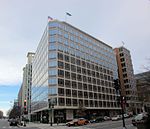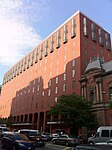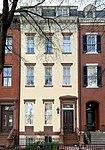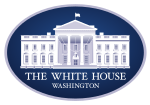Renwick Gallery
1972 establishments in Washington, D.C.Art galleries established in 1972Art museums and galleries in Washington, D.C.Art museums established in 1972Contemporary crafts museums in the United States ... and 6 more
Decorative arts museums in the United StatesJames Renwick Jr. buildingsMembers of the Cultural Alliance of Greater WashingtonNational Historic Landmarks in Washington, D.C.Northwest (Washington, D.C.)Smithsonian Institution museums

The Renwick Gallery is a branch of the Smithsonian American Art Museum, located in Washington, D.C., and focuses on American craft and decorative arts from the 19th to the 21st century. It is housed in a National Historic Landmark building that was begun in 1859 on Pennsylvania Avenue and originally housed the Corcoran Gallery of Art (now one block from the White House and across the street from the Old Executive Office Building). When it was built in 1859, it was known as "the American Louvre".
Excerpt from the Wikipedia article Renwick Gallery (License: CC BY-SA 3.0, Authors, Images).Renwick Gallery
17th Street Northwest, Washington
Geographical coordinates (GPS) Address Nearby Places Show on map
Geographical coordinates (GPS)
| Latitude | Longitude |
|---|---|
| N 38.898866666667 ° | E -77.039447222222 ° |
Address
Potbelly
17th Street Northwest 700
20006 Washington
District of Columbia, United States
Open on Google Maps








